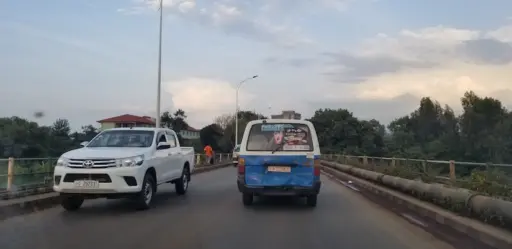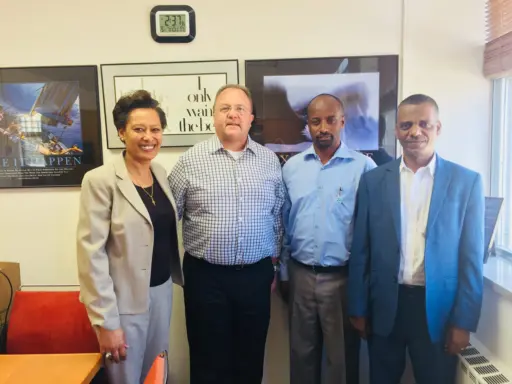To cross the Blue Nile River in Bahir Dar, Ethiopia, there’s only one option, short of braving the dark waters below. An aging, narrow bridge serves all types of travelers: cars, bikes, mopeds, rickshaws, pedestrians, even livestock.
And, as you might expect, that kind of competition for two lanes can quickly—and routinely—bring traffic to a standstill.
 The existing, outdated bridge in Bahir Dar, Ethiopia. Photo courtesy of Yimer Degu Ayicheh.
The existing, outdated bridge in Bahir Dar, Ethiopia. Photo courtesy of Yimer Degu Ayicheh.
“It has lived its life,” says Rahel Desalegne, an adjunct professor in the Department of Civil and Environmental Engineering at the University of Wisconsin-Madison and a native of Ethiopia. “There are a lot of safety issues and it doesn’t serve the capacity.”
Desalegne is part of a UW-Madison team that’s lending expertise as advisors on the design of a new bridge that will accommodate—and encourage—multiple modes of transportation in the city of more than 600,000. It’s one of several projects the department has undertaken in recent years in the East African country and part of a global mentality: Civil and environmental engineering faculty currently have ongoing research work on five of the world’s seven continents, improving infrastructure and examining environmental issues.
“It’s important for us as a leading university to really try to make an impact around the world,” says department chair David Noyce, the Dr. Arthur F. Hawnn Professor. “Our faculty think that way as well.”
Noyce is part of the group adding insight to the new bridge project in Bahir Dar, a regional capital city set on a large lake and home to a large university. Those similarities to Madison have made UW-Madison a natural partner for creating a bicycling plan for Bahir Dar. And while working with Jonathan Patz, director of the Global Health Institute at UW-Madison, on strategies for bike lanes, Desalegne and Noyce learned about plans for a new bridge.
 Adjunct Professor Rahel Desalegne, Professor David Noyce, Bahir Dar University researcher Yimer Degu Ayicheh and Bahir Dar mayor Ayenew Belay. Photo courtesy of Rahel Desalegne.
Adjunct Professor Rahel Desalegne, Professor David Noyce, Bahir Dar University researcher Yimer Degu Ayicheh and Bahir Dar mayor Ayenew Belay. Photo courtesy of Rahel Desalegne.
Desalegne and Patz have met with the Ethiopian Roads Authority on multiple occasions to advocate for a design that serves more than just automobiles. The good news: The current plans, which are in the early stages of design, call for two vehicular lanes, two bike lanes and a pedestrian lane in each direction. Noyce, Desalegne and faculty from Bahir Dar University are also pushing to add sensors to the bridge that will allow researchers and students at both universities to monitor its structural health in the future.
Meanwhile, near the border with Sudan to the west sits the hulking—but yet to be completed—Grand Ethiopian Renaissance Dam, one focus of Assistant Professor Paul Block’s work since construction began in 2011.
Block, who’s been working on projects involving the Nile River Basin since the early 2000s, addresses how policies and strategies regarding dam management may affect water availability and energy generation—not just in Ethiopia, but downstream in Sudan and Egypt as well. It’s a tense, layered political situation.
“We hope to have a voice in the conversation,” says Block, who uses forecasts for upcoming seasons to predict climate impacts on water resources in the region. “My desire is to see positive outcomes across the basin. And if there are ways that we can contribute to that—and more than likely small ways, but maybe some important ways—I’m all for it.”
Block collaborates with a wide range of researchers—ethnographers, applied economists, life sciences communication faculty and more—to better understand infrastructure and agricultural decision-making at vastly different scales, from rural farmers to national entities.
He’s also working on a two-year project funded through the UW2020 initiative with extensions to Ethiopia. With the help of Patz and others, including the International Federation of the Red Cross, the team is creating an early warning system that could alert disaster relief organizations months in advance of potential floods—not only addressing preparedness but also health, social and financial outcomes.
“We talk about the Wisconsin Idea. The people of Wisconsin are also global citizens,” Block says. “I don’t think you have to take too many steps to see how we are all connected in some sense.”